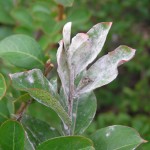Fungi, mold or mildew, which is correct?
- Posted on: September 27, 2011
 Have you ever noticed how the terms mold, mildew and fungi are all seemingly used for the same fuzzy stuff? Here at the lab we get the question frequently or more often than not a customer will say something like “well, it’s just normal mildew and not the black mold”. In response, we thought it might be helpful to do a blog post to clear up the confusion.
Have you ever noticed how the terms mold, mildew and fungi are all seemingly used for the same fuzzy stuff? Here at the lab we get the question frequently or more often than not a customer will say something like “well, it’s just normal mildew and not the black mold”. In response, we thought it might be helpful to do a blog post to clear up the confusion.
Let’s start with some definitions:
MOLD: a filamentous fungus, generally appearing as a circular colony that may be cottony, wooly, or glabrous, but with filaments that are not organized into large fruiting bodies, such as mushrooms(1). Also defined as fungal colonies composed of hyphae(2)
MILDEW: a superficial, usually whitish growth produced… on organic matter or living plants by fungi(3), or a plant disease caused by such fungi.(4)
FUNGI: kingdom Fungi, (the taxonomic kingdom including yeast, molds, smuts, mushrooms, and toadstools; distinct from the green plants)(5)
Ok, so now that we have the terms, let’s boil that down.
First, anything living is put in to one of these five categories:
 Plant Animal Bacteria Protista
Plant Animal Bacteria Protista
Of course we are not concerned with the Plant, Animal, Bacteria or Protista Kingdoms for the purpose of this blog post, we’ll direct our focus to the Fungi heading. Fungi is one of the five kingdoms of the scientific taxonomic classification system.
Then under Fungi, the next sub heading down would be Mold. However, mold is not a scientific taxonomic term of sorts but more of a generic term used to refer to any circular colony forming spots on a substrate. Mold is what we commonly call the stuff we can see growing on contaminated walls, fruit, paper etc.
Last, under the sub heading Mold, is the sub sub heading Mildew. Again, Mildew is not a taxonomic term but is a specific type of growth. Typically you’ll see mildew on plants and trees and it is commonly called “powdery mildew” because it appears white and powdery to the naked eye. In fact, I have a few
santarosa.ifas.ufl.edu/lawn_garden_faq.shtml
crepe mrytles in my yard that get powdery mildew quite frequently. The specific name of the spores of Downy and powdery mildew types are Peronospora and Oidium. You may haven even seen these spore types listed on mold test results or on mold reports.
So how did you do? Were you using the terms correctly?
Pass it on with our Share button below, or send us some feedback.
Sources:
- Web MD: http://dictionary.webmd.com/terms/mold
- Fundamentals of Diagnostic Mycology by W.B. Saunders Company- Fisher Cook pg.280
- Merriam-webster.com: http://www.merriam-webster.com/dictionary/mildew
- The Free Dictionary: http://www.thefreedictionary.com/mildew
- From word net web: http://wordnetweb.princeton.edu/perl/webwn?s=fungi




